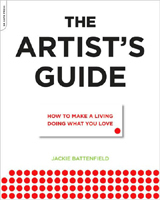Artists: How to Earn and Manage Money, Part II (2009)
The following is an excerpt from Jackie Battenfield’s The Artist’s Guide: How to make a living doing what you love.
Creative Business & Entrepreneurship | 22 February 2011

What can you do (or what skill can you develop) that will provide the most money with the fewest number of hours and stress? Ah yes, the punch line. Always treasure and protect your creativity. Everyone has different financial needs and stress points. Know what yours are, and avoid locking yourself into work situations outside the studio that do not contribute to your creative well-being. Look for work that’s rewarding but also pays well enough to help you with your artistic goals. If your job or freelance business is so stressful that you spend more time doing “retail therapy” than art, maybe you should look for a more serene way to earn an income.
Do you know freelancers doing the kind of work you are interested in developing? Offer to take them out to lunch and interview them about how they manage. What are the pros and cons of their business? If they could begin all over again, what would they do differently? What mistakes did they make that you should avoid? What other advice do they have for you? Don’t be shy. It may be that some will see you as a potential competitor and not want to share any information, and others will be generous with their advice. Try speaking with freelancers outside of your community, in another town or location where they won’t feel as threatened. If someone provides a bleak picture to discourage you, interview a few others to get a more rounded point of view.
Because of the irregularity of your freelance income, one month you may be flush, while the next one money barely trickles in. You need to be comfortable managing your time and finances with a steady hand amid the ups and downs. Running your own businesses—you may separate your freelance business from your fine art sales—also requires you to be your own human resources department. That means researching and selecting health insurance policies, pension plans, paying quarterly taxes, etc. Planning for all of these expenses is important.
No matter what avenue you choose, the goal is to assemble the right mixture of activities that result in a lifestyle in which you are doing more than surviving. Many artists seek to earn just enough to scrape by, working at marginal positions or for cash “off the books” year after year. They neglect their finances because they hope a solution will come when they make it big and finally achieve fame and fortune with their art. I’m not trying to puncture anyone’s big dream, as I’m all for dreaming big. However, laying a more secure financial base, developing many income streams, paying taxes, and using your creative energies to live well will not diminish striving for that goal.
Artists: How to Earn and Manage Money, Part I | Part II
This excerpt is on pages 172-73 in the chapter: “How to Earn and Manage Money”. The Artist’s Guide: How to make a living doing what you love (2009) is published by Da Capo Press. For more information and reviews, click the link above the article.